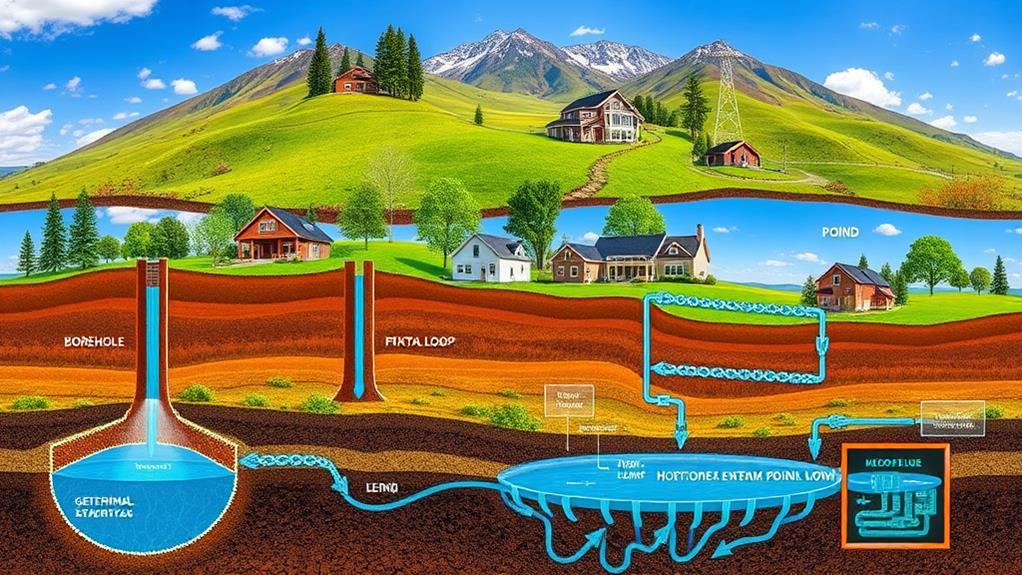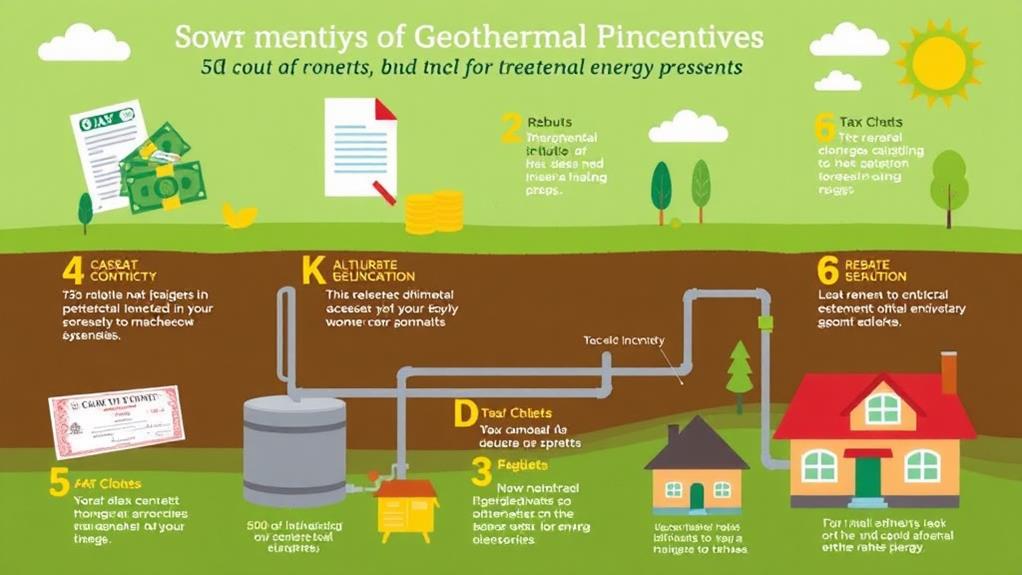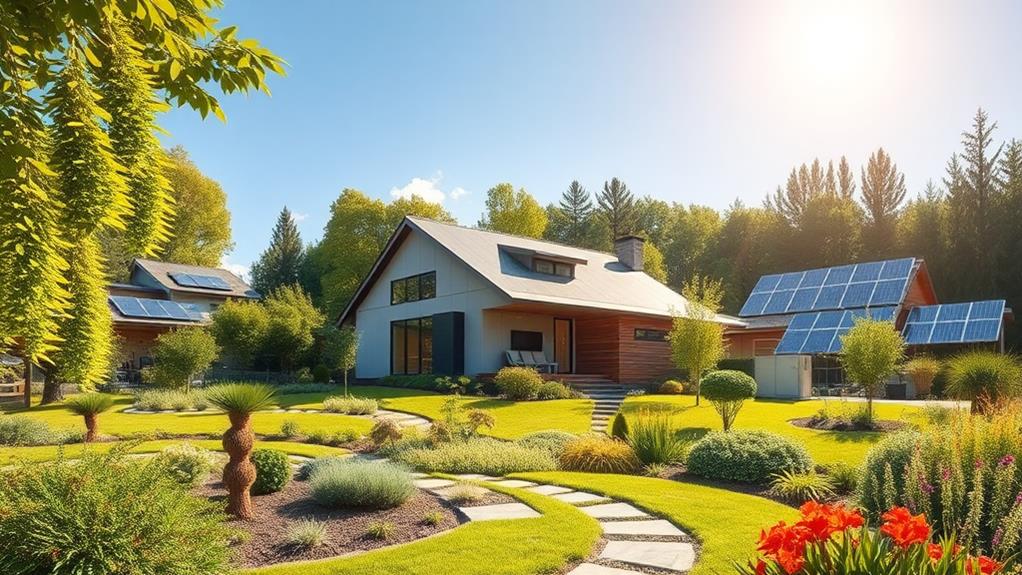In evaluating the 10 best geothermal energy systems, we consider several cost factors and value propositions. Installation typically ranges from $17,000 to $32,300, influenced by system type, size, and local geology. Closed loop systems average $25,000 to $30,000, while vertical systems can reach up to $40,000. We must also account for additional costs like ductwork and permits, totaling around $2,000 to $7,000. The long-term benefits include substantial energy savings, with annual reductions averaging $1,400, a payback period of 5 to 10 years, and federal tax credits enhancing affordability—continue with us to uncover more insights.
Key Takeaways
- Geothermal systems typically cost between $17,000 and $32,300, with an average installation cost of around $24,500.
- Closed loop systems are ideal for extreme climates, while open loop systems depend on local water supply availability.
- Installation costs can vary based on system size, loop type, local geology, and additional expenses like ductwork and permits.
- Homeowners can save approximately $1,400 annually on energy bills, with a payback period of 5 to 10 years.
- Federal tax credits of up to 26% can significantly offset initial installation costs, enhancing financial viability.



Cost Overview of Geothermal Systems
When considering a geothermal energy system, we should take a close look at the overall costs involved. A thorough cost overview reveals that the average installation cost for these systems is approximately $24,500, with variations ranging from $17,000 to $32,300. Installation costs typically fall between $8,000 and $24,000, influenced by factors such as system size, loop type, and local geology. The geothermal heat pump cost generally ranges from $4,000 to $7,000, while additional expenses, including ductwork, can vary from $2,000 to $6,000. Yardwork for excavation might add $5,000 to $15,000. Permit costs, depending on the area, can range from $100 to $1,000. Energy savings over time can offset these upfront costs considerably, making this investment worthwhile.
Types of Geothermal Systems

Geothermal systems come in various types, each tailored to different needs and environmental conditions. Closed Loop Systems circulate a water/antifreeze mixture through underground pipes, making them ideal for extreme climates, with installation costs averaging between $25,000 and $30,000. Alternatively, Open Loop Systems draw water from wells or surface bodies, but they require a consistent water supply, limiting their commonality. For those with ample land, Horizontal Loop Systems are typically installed in trenches 2-10 feet deep, costing between $15,000 and $30,000. Vertical Loop Systems, designed for space efficiency, can extend up to 400 feet deep, with installation costs ranging from $25,000 to $40,000. Finally, Pond/Lake Systems utilize water bodies for heat exchange, providing a cost-effective solution if available.
Installation Costs and Influencing Factors

Understanding the installation costs of geothermal systems is essential for anyone considering this renewable energy option. Typically, installation costs range from $8,000 to $24,000, influenced by factors such as system size and the type of ground loop utilized. For instance, horizontal loop systems can cost between $15,000 and $30,000, while vertical loop systems may range from $25,000 to $40,000 due to their complex installation requirements. Local geology can greatly affect site accessibility and, consequently, the upfront cost, as can additional expenses for ductwork, typically ranging from $2,000 to $6,000, and excavation and trenching, which can add between $5,000 and $15,000. Permits may also incur costs from $100 to $1,000, depending on local regulations.
Equipment and Labor Costs

In this section, we’ll examine the equipment and labor costs associated with geothermal energy systems, which are essential for understanding the overall investment. The expenses for heat pumps can vary considerably, typically ranging from $4,000 to $7,000, while additional components like air handlers often add $2,000 to $3,000 to the total cost. Furthermore, professional installation is highly recommended due to the system’s complexity, with labor fees contributing anywhere from $8,000 to $24,000, leading to an average total installation cost between $24,500 and $32,300, depending on various site-specific factors.






Heat Pump Pricing Factors
When considering a geothermal heat pump system, we should keep in mind several pricing factors that can greatly affect our overall investment. First, heat pump costs typically range from $4,000 to $7,000, depending on the efficiency ratings and system size. Next, installation labor costs can vary considerably, averaging between $8,000 and $24,000, influenced by local labor rates and loop type. Additional equipment costs, such as air handlers, can add $2,000 to $3,000 to our budget, while ductwork installation may incur costs between $2,000 and $6,000, based on existing infrastructure. Finally, permit costs can range from $100 to $1,000, depending on local regulations, which we must also factor into our total project expense when planning geothermal systems.
Installation Labor Considerations
Installation labor plays an essential role in the overall cost of geothermal systems, with expenses typically ranging from $8,000 to $24,000. These labor costs can vary considerably based on system size, loop type, and local labor rates. Engaging in professional installation is vital, given the complexity of geothermal systems that involve excavation, trenching, and the installation of underground loops. Additionally, installation expenses can escalate if ground conditions are challenging or access to the site is difficult, potentially requiring specialized equipment. Permitting costs, which generally fall between $100 and $1,000, further influence overall installation expenses, depending on local regulations and the type of system being installed. Understanding these factors helps us make informed decisions about geothermal systems.
Benefits of Geothermal Systems

As we explore the benefits of geothermal systems, we’ll notice their significant contributions to environmental impact reduction, long-term cost savings, and energy efficiency. By harnessing the Earth’s consistent ground temperatures, these systems not only lower our energy bills—up to 50% for heating and 35% for cooling—but also minimize our carbon footprints in comparison to traditional HVAC systems. With impressive lifespans of over 50 years for ground loops and federal tax credits enhancing affordability, investing in geothermal technology proves to be a durable and economically sound choice for homeowners.
Environmental Impact Reduction
While many of us seek sustainable solutions to combat climate change, geothermal energy systems stand out for their impressive ability to reduce environmental impact. By leveraging the earth’s stable temperatures, these systems can cut carbon emissions by up to 50% compared to traditional fossil fuels, considerably aiding mitigation efforts. Additionally, geothermal systems enhance energy efficiency, lowering energy consumption by 25-50%, which fosters a more sustainable lifestyle. Their minimal environmental footprint, requiring less land and producing no air pollutants, supports ecosystem health. Furthermore, by utilizing renewable energy, we can achieve greater energy independence and lessen reliance on non-renewable sources, propelling us toward a greener energy landscape that aligns with our collective environmental goals.
Long-Term Cost Savings
Geothermal energy systems offer significant long-term cost savings that can greatly benefit homeowners. These systems can achieve energy savings of 25-50% on heating and cooling costs, leading to substantial reductions in utility bills. With an average annual savings of $1,400, we can appreciate the financial benefits over time. The payback period typically ranges from 5 to 10 years, making the initial cost more manageable, especially with federal tax credits of up to 30% and state-specific rebates. Given their expected lifespan of 25 to 50 years, geothermal systems present a reliable, energy-efficient investment for the long run.
| Benefit | Details |
|---|---|
| Annual Savings | ~$1,400 on utility bills |
| Payback Period | 5 to 10 years |
| Installation Costs | Up to 30% tax credit available |
| Lifespan | 25 to 50 years |
Energy Efficiency Benefits
Having explored the long-term cost savings associated with geothermal energy systems, it’s clear that these systems also excel in energy efficiency. Geothermal heat pumps, which provide an effective heating and cooling system, can reduce heating costs by up to 50% and cooling costs by up to 35% compared to traditional HVAC systems. With efficiency ratings of 3 to 4.5 times energy output versus input, these systems considerably lower overall energy consumption. Additionally, heat pump installation can yield annual utility savings of around $1,400, with payback periods of 5 to 10 years. Federal tax credits of 26% further enhance their financial viability, making geothermal systems a compelling choice for long-term energy savings and sustainability.
Drawbacks of Geothermal Systems

When considering geothermal systems, it’s important to be aware of several significant drawbacks. First, the high initial installation costs can range from $18,000 to $30,000, representing a considerable investment for many homeowners. Additionally, reliance on electricity to power heat pumps can result in increased energy bills, particularly in regions with elevated electricity rates. The installation process often demands substantial yard space for underground loops, which can be a limitation for properties with smaller lots. Furthermore, challenging site conditions, such as rocky soil or limited access, may complicate installation and heighten labor costs. Finally, the applicability of geothermal systems hinges on local geology, which must support the installation of underground loops, potentially restricting options in certain areas.
Real-Life Pricing Examples

With the drawbacks of geothermal systems in mind, it’s helpful to look at some real-life pricing examples to better understand the financial commitment involved. Typically, the installation costs for a geothermal heat pump system range from $18,000 to $30,000, depending on factors like loop type and home size. For a 2,000 sq. ft. home, real-life installation costs can vary from $15,000 to $50,000, especially if existing ductwork is in good condition. The average payback period for these systems is generally between 5 to 10 years, influenced by energy savings and the initial investment. Additionally, federal tax credits of 26% can greatly offset upfront costs, making geothermal systems a more attractive option for homeowners.
Financial Incentives and Rebates

Many homeowners may not realize the substantial financial incentives and rebates available for installing geothermal energy systems. Federal tax credits can cover 26% of installation costs, providing considerable relief through 2022 and beyond. Additionally, many states, including Massachusetts and Pennsylvania, offer specific programs that further reduce installation expenses. By taking advantage of these financial incentives, homeowners can greatly enhance the affordability of this eco-friendly energy solution. With average annual energy savings of approximately $1,400, the return on investment becomes more attractive, as the payback period typically ranges from 5 to 10 years. As a result, shifting to geothermal not only decreases utility bills but also represents a financially viable long-term investment for homeowners seeking sustainable energy solutions.
Ideal Candidates for Geothermal Systems

When considering geothermal systems, it’s essential for us to identify the ideal candidates who stand to benefit the most from this technology. Long-term homeowners, particularly those in regions with extreme climates, can maximize their return on investment, as the significant energy savings often lead to payback periods of 5 to 10 years. Additionally, properties with sufficient land for installation and a suitable landscape can accommodate the necessary horizontal or vertical loop systems, enhancing overall efficiency and minimizing installation costs.
Long-term Homeowners Benefits
Long-term homeowners stand to gain substantially from investing in geothermal energy systems. These systems offer remarkable energy savings of 25-50% on heating and cooling costs, making them a financially sound investment. With an average payback period of 5 to 10 years, we can recoup our initial costs through reduced utility bills. Federal tax credits ranging from 22% to 30% enhance the affordability of these installations. Significantly, homes in extreme climates benefit from consistent underground temperatures, leading to enhanced energy efficiency.
| Benefit | Description | Impact on Homeowners |
|---|---|---|
| Energy Savings | 25-50% reduction on bills | Lower monthly expenses |
| Tax Credits | 22%-30% federal incentives | Increased affordability |
| Long Lifespan | Systems last 25-50 years | Sustained home value increase |
Suitable Landscape Requirements
Selecting the right landscape for geothermal systems is essential for maximizing their efficiency and effectiveness. Ideal candidates typically have well-drained soil, as poor drainage can hinder installation and reduce system performance. For horizontal loop systems, we need around 1,000 to 2,000 square feet, while vertical loop systems require less surface area but involve deep drilling. Properties situated in regions with consistent ground temperatures between 45-75 °F enhance energy efficiency considerably. Additionally, for those with water sources, open-loop systems offer a cost-effective alternative, although they are less common. It’s vital to evaluate local regulations and zoning laws, as these can dictate the permissible types of geothermal systems based on landscape characteristics and environmental impact.
Climate Considerations Impacting Efficiency
Understanding the landscape requirements for geothermal systems sets the stage for evaluating how climate factors into their efficiency. Climate considerations play a significant role in determining the effectiveness of these systems. For instance, homes in extreme climates often experience significant energy savings, with reductions of 25-50% in heating and cooling costs. Additionally, stable ground temperatures between 45-75 °F enhance system performance, while appropriate soil types and local geology contribute to installation viability.
| Climate Factor | Impact on Efficiency | Ideal Conditions |
|---|---|---|
| Ground Temperature | Enhances system performance | 45-75 °F |
| Soil Type | Affects installation costs | Moist, stable |
| Local Geology | Influences system viability | Suitable geology |
Long-Term Value and Savings

Geothermal energy systems offer a compelling solution for homeowners looking to reduce their energy expenses over time. By investing in these systems, we can access substantial long-term savings while enhancing energy efficiency. Here are some key benefits to evaluate:
- Reduced heating and cooling costs: Geothermal systems can lower expenses by 25-50% compared to conventional systems.
- Payback period: Expect a return on investment within 5 to 10 years, depending on initial installation costs and energy savings.
- Federal tax credits: Up to 30% available, greatly reducing upfront costs.
- Reliable energy savings: With an expected lifespan of 25-50 years, geothermal systems deliver consistent annual energy savings, averaging around $1,400, ensuring financial viability.
Frequently Asked Questions
How Much Does It Cost to Install a Geothermal Energy System?
When considering geothermal energy system installation costs, we should factor in system types, geographic considerations, and incentive programs. The long-term investments lead to energy savings and environmental benefits, despite maintenance costs. Let’s explore together!
How Long Does It Take for Geothermal to Pay for Itself?
Imagine planting a tree; it takes time to bear fruit. Similarly, the payback period for geothermal systems is 5-10 years, but with energy savings, efficiency ratings, and financing options, our environmental impact grows for decades.
How Much Does a Geothermal System Cost per Ton?
When we consider geothermal system costs per ton, we should factor in installation aspects, energy efficiency, and maintenance needs. Understanding system types and available incentives can help debunk geothermal myths, leading to smarter choices together.
What Is the Best Rated Geothermal Heating and Cooling?
When we explore the best-rated geothermal heating and cooling, we uncover incredible geothermal benefits, unmatched system efficiency, and amazing energy savings. Plus, with smart technology advancements, the installation process and maintenance tips become a breeze for us!









